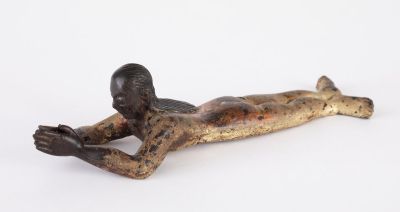
Sumedha
| Accession Nr.: | 2874 |
|---|---|
| Type: | statuette; pottery |
| Date of production: |
18th (?) century
|
| Place of production: |
| Materials/Techniques: | earthenware, lacquered, gilt |
|---|---|
| Dimensions: | height: 4. 5 cm length: 17 cm width: 4. 5 cm |
A figure with a raised head, lying on its belly, holding up his hands in homage. The naked body of the sculpture is covered in lacquer and gilding, his face rounded, his forehead broad, his long hair neatly slicked back.
Sumedha is one of the best-known figures in the Buddhist canon, an ascetic who is believed by some sources to be an earlier incarnation of the historical Buddha. The sculpture refers to the story of Sumedha's encounter with the Buddha of the past, called Dipankara. It was during this encounter that he offered his body as a bridge so that Dipankhara and his disciples could cross a muddy stretch of road with dry feet. Dipankhara then prophesied that he would later become the Sakyamuni, mentioning the names of his closest disciples. Sumedha became an emblematic figure of total devotion for the followers of Theravada Buddhism.
Sumedha is one of the best-known figures in the Buddhist canon, an ascetic who is believed by some sources to be an earlier incarnation of the historical Buddha. The sculpture refers to the story of Sumedha's encounter with the Buddha of the past, called Dipankara. It was during this encounter that he offered his body as a bridge so that Dipankhara and his disciples could cross a muddy stretch of road with dry feet. Dipankhara then prophesied that he would later become the Sakyamuni, mentioning the names of his closest disciples. Sumedha became an emblematic figure of total devotion for the followers of Theravada Buddhism.
